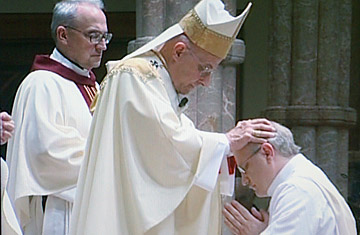
Fr. Michael Scherschel, a local Chicagoan, gets blessed by Cardinal Francis George during a recent ordination ceremony at Holy Name Cathedral in Chicago. Scherschel, 42, is emblematic of a local push to get more homegrown Catholics into the pulpit.
And if the Chicago Archdiocese succeeds in a new push, Scherschel will soon be joined by many more homegrown members of the clergy. Beginning July 1, the church will launch a drive to find more of them, using the 500 or so active priests across the city and suburbs to help spread the word. Roughly a dozen full- or part-time priests will work Chicago's 80 neighborhoods and northern suburbs much like recruiters for the police or fire department or any business group would. Schools will be visited in the 364 local parishes, as well as public and private institutions, colleges and universities and career fairs, as the archdiocese looks to reverse a trend in which, currently, about 90% of all seminary freshmen drop out.
The archdiocese has one thing going for it that other career recruiters don't — a captive audience. Some 2.3 million Catholics attend more than 1,700 weekly masses here. The U.S. Conference of Catholic Bishops applauds the effort, saying this "fishers of men" approach at the local level could help cultivate a corps of priests in Chicago that not only knows the language of the neighborhood, but the politics and the culture that helped develop it and the people who live there.
"It's drawing from their own people, and that's part of who we are as Catholics," says Monsignor Edward Burns, head of priestly and vocational services for the bishops conference. "We need to identify the future leaders of the church, and just as the parish comes forth and celebrates with bread and wine and the sacraments, sometimes parents in a community feel this need to pray and say to God, if you want one of my sons to serve you, by all means touch his heart."
Experts are unaware of any similar formal local recruiting effort elsewhere in the country. But over the years, from New Hampshire and Maine to Iowa, Mississippi and Wisconsin, many tactics have been employed to lure a new generation of Catholics to the priesthood — Internet campaigns, TV commercials, high school marketing and nominating petitions in dioceses. In this new campaign, the archdiocese will rely on a more intimate approach, appointing a new vocation director, at least 12 full- and part-time priests, and using pastors at regular masses to spread the word from the pulpit during homilies and announcements — or by simply walking up to strong lay members and asking if they have heard the call. "Many of the recently ordained foreign-born priests said that's precisely what led them to consider being priests," says James Accurso, a spokesman for the Chicago archdiocese.
But in a city that is now 37% black and 26% Latino, the trick is not to simply replace retiring white men with young white men. Even with the international push over the past 20 years or so, the archdiocese struggles to reflect its flock in the racial breakdown of the parishioners and those who tend to them. While about 90% of the active priests are white, only about half of all congregants are white, with 40% Hispanic or Latino, 4% African American, and 4.5% listed as Asian or "other." So just as the Church went on a global hunt for priests in years past to tend to the flock in their own language, the archdiocese here is trying to recruit a U.N. corps of clergy by mining local neighborhoods filled with Korean and Chinese, Urdu, Hindi and Polish, French, German, Italian and all manner of Spanish and African dialects.
"There's something to be said for a great voice to so many cultures and nations in one church," says Fr. Thomas Baima, provost of the University of St. Mary of the Lake-Mundelein Seminary. "But the numbers are down. Society has changed. We need to reach out differently."
Certainly the way they have been reaching out at home hasn't been working so well. Since 1980, the priesthood in Chicago alone has dropped from more than 1,200 in 1980 to just over 800 now (including retired or otherwise not practicing priests). Nationwide, one in every three Catholic priests is now foreign born, with the fastest-growing group of Hispanic descent. "The priesthood," Baima says, "isn't a normal career, or a career at all. It's more akin to marriage; it's total engagement. There's a personal dialogue in inviting someone to become a priest that you can't put side by side with the law or medicine or police."
So is Fr. Scherschel the right man for the job? The archdiocese says yes — for his parish, in the mostly white neighborhood on the northwest side. Just as important, perhaps, is his age, over 40. The average age for making commitments in general has risen dramatically, matching changes in society, with people getting married and making other life decisions later and later. Baima says, "A full 10 years has been added to making these lifelong decisions. This is as much about a social change as it is about religion, really."
Exactly, says Scherschel. "I asked God if I could do something else," said Scherschel, who was making good money in advertising before deciding to become a priest. It was exciting, creative, and more rungs on the ladder were ahead. "But this is of the spiritual, and that is critical. My life's not supposed to be about increasing my own worth anymore."
